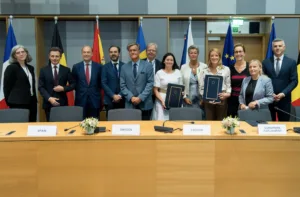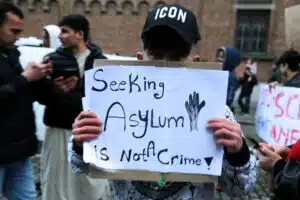Brussels – The EU Parliament’s Contact Group on Asylum met on January 31 with the five rotating Council presidencies who signed the roadmap a year and a half ago to hammer out the last details of the Migration and Asylum Pact after the general agreement reached at the end of December. The Pact should be approved within the next two months, in time for the end of the legislative term.

“We are approaching the final stages of the reform of Europe’s asylum and migration rules,” EU Parliament chief Roberta Metsola said about the progress made since December 20, 2023, when the “historic” agreement on the Migration and Asylum Pact. “Europe will now have a strong and equal legislative framework in all member states that works and protects, a humane and fair approach with those who seek protection, firm with those who are not entitled and strong with those who exploit the most vulnerable,” she said at the final meeting between the informal working group bringing together the MEPs rapporteurs on the Migration and Asylum Pact dossiers (nine, only the Return Directive did not make it to the finish line) and the representations of Belgium, Spain, Sweden, the Czech Republic and France.
“We achieved the goal of our agreed cooperation on the implementation of one of the most important pieces of legislation in this mandate,” the Chair of the Contact Group on Asylum, Elena Yoncheva, said, putting an end to the 17 months of agreed cooperation in September 2022 to conduct inter-institutional negotiations. “The negotiations were long, difficult, and complex for all parties,” Yoncheva added, omitting, however, that the agreement came abandoning all the red lines and guarantees set by MEPs in the original negotiating positions. “We are now heading into the final stages to provide a common European response to the challenges of migration,” barring unlikely (but not impossible) sinkings upon approval by each of the two co-legislators.
The basis of the Migration and Asylum Pact
 At the heart of the Migration and Asylum Pact system is the relationship between solidarity and responsibility in managing migrants in the 27 Member States. The former concept permeates the Regulation for the Management of Asylum and Migration (RAMM), which in no way overrides the cardinal principle of the 2013 Dublin Regulation, namely that the task of examining the asylum claim of a person who irregularly enters EU territory rests with the first EU member state of entry. Countries like Italy, Greece, Malta, Cyprus, and Spain will be responsible for applications. Other member states that want to ‘Dublin’ (i.e., extradite) these migrants – including minors and those applying for reunification with siblings – will have to send a notification, no longer a reciprocal due process request, with the agreement of the country of first arrival as is the case today. After the Regulation enters into force – 24 months after its publication in the EU Official Journal – the now famous mandatory solidarity mechanism for all Member States (based on GDP and population) will be introduced, which equalizes three forms of solidarity: relocations of migrants, financial contributions, or support to third countries. Contributions to member countries can go to reception systems and fixed and mobile border facilities through the Border and Visa Management Instrument (BMVI) and the Asylum, Migration, and Integration Fund (AMIF). There will be no mandatory relocation for migrants disembarked after search and rescue operations at sea, and for those under the RAMM procedure, there is no legal representation, only counseling.
At the heart of the Migration and Asylum Pact system is the relationship between solidarity and responsibility in managing migrants in the 27 Member States. The former concept permeates the Regulation for the Management of Asylum and Migration (RAMM), which in no way overrides the cardinal principle of the 2013 Dublin Regulation, namely that the task of examining the asylum claim of a person who irregularly enters EU territory rests with the first EU member state of entry. Countries like Italy, Greece, Malta, Cyprus, and Spain will be responsible for applications. Other member states that want to ‘Dublin’ (i.e., extradite) these migrants – including minors and those applying for reunification with siblings – will have to send a notification, no longer a reciprocal due process request, with the agreement of the country of first arrival as is the case today. After the Regulation enters into force – 24 months after its publication in the EU Official Journal – the now famous mandatory solidarity mechanism for all Member States (based on GDP and population) will be introduced, which equalizes three forms of solidarity: relocations of migrants, financial contributions, or support to third countries. Contributions to member countries can go to reception systems and fixed and mobile border facilities through the Border and Visa Management Instrument (BMVI) and the Asylum, Migration, and Integration Fund (AMIF). There will be no mandatory relocation for migrants disembarked after search and rescue operations at sea, and for those under the RAMM procedure, there is no legal representation, only counseling.
The concept of accountability is linked to the Asylum Procedures Regulation (APR), which increases only those provided for countries of first entry. It will apply automatically in case of risk for security threats – including unaccompanied minors – of “deception of authorities” or if the migrant comes from a country with a recognition rate of less than 20 percent. Border procedures will provide de facto detention, with no exemptions even for families with children under 12, nor legal representation, nor a stay for appeals against most decisions (the exception is for inadmissibility of those based on the concept of “safe third country” and for unaccompanied minors). Crucial to this Regulation is the “Safe Third Country” concept, for which both EU and national lists are provided to justify and expedite rapid returns out of the Union unless the individual is at risk in the state involved. New accountability obligations include completing the examination of an asylum application through the border procedure within six months (APR) but also extending the period of responsibility for handling applications to 20 months and maintaining at 12 months that for search and rescue operations at sea (RAMM). The annual ceiling for border procedure is 30,000 people, determined based on a formula that considers the number of irregular border crossings and expulsions in the previous three years.
What happens when migrants arrive
.

(credits: Alessandro Serranò / Afp)
Once migrants arrive at the Union’s borders, the Screening Regulation of the Migration and Asylum Pact will provide a 7-day detention period to classify the procedures as regular (RAMM) or expedited (APR) to process their asylum claims. Since the so-called ‘fiction of non-entry’ has remained – that is, anyone screened in a special center will not be considered legally on the territory of the member state, and therefore of the EU – migrants will be detained as they will have to remain at the disposal of authorities without the possibility of entering national soil. Some guarantees include the possibility for applicants to have access to a copy of the screening form and the preservation of the “relevant rules on detention” set out in the 2008 Return Directive (the revision contained in the Migration and Asylum Pact is the only dossier that is certain to fail). The monitoring mechanism – which does not necessarily include NGOs but can at the discretion of states – does not apply to border surveillance activities (with normalization of racial profiling). If the State recognizes a security threat, it can grant national authorities direct access to all data on the person in all databases. About databases, according to the Eurodac Regulation, all migrants benefiting from temporary protection from the age of 6 will have to accept giving their biometric data, even though under the General Data Protection Regulation (GDPR), processing is lawful only if the minor is at least 16 years old. Included expanding data access for national authorities is collecting photographs of faces, effectively giving the green light to mass surveillance of people arriving on EU soil. Security alerts entered into the Eurodac database during the screening process, and border procedures will include a whole range of new categories – such as irregular border crossing – through the revision of the Entry and Exit System Review Regulation.
What happens in a crisis
. 
One of the most controversial items in the Migration and Asylum Pact is the Regulation for Crises, Instrumentation, and Force Majeure, which deals with times when there is an exceptional or unexpected “mass arrival of people,” including following a disembarkation after a search and rescue operation at sea. The Council’s negotiating position passed, which led to the inclusion of instrumentality (a Regulation that was initially a stand-alone and on which Parliament had not given the green light) in case of crises and force majeure, when “a hostile third country or non-state actor encourages or facilitates the movement of third-country nationals and stateless persons” towards the EU external borders “aiming to destabilize the Union or a Member State” by putting “the essential functions of a Member State at risk.” NGOs are excluded from this definition, but only if they can demonstrate that their actions (at sea and otherwise) are not intended to destabilize, with clear risks of repercussions for the criminalization of solidarity.
There is no compulsory relocation of migrants between member countries in crises but the same three modes of solidarity as in the Ramm Regulation (relocations, financial contributions, or support to third countries) will apply. Instead, exceptions to the overall migration and asylum management system are triggered in this scenario: the recognition rate threshold for which people can be admitted to border procedures (under the Apr Regulation at 20 percent) is raised to 50 percent for force majeure, 60/70 percent in crises, and 100 percent in instrumentality situations. Also, in border procedures – the duration of which can be extended by an additional six weeks (compared to the nine months in April) – families with children under the age of 12 are not excluded.
English version by the Translation Service of Withub




